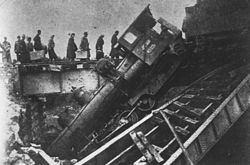Uprising in Serbia (1941)
| Uprising in Serbia | |||||||
|---|---|---|---|---|---|---|---|
| Part of World War II in Yugoslavia | |||||||
 Destroyed German train in Serbia, 1941 |
|||||||
|
|||||||
| Belligerents | |||||||
|
|
|||||||
| Commanders and leaders | |||||||
|
|
|
||||||
The Uprising in Serbia was initiated in July 1941 by the Communist Party of Yugoslavia against the German occupation forces and their Serbian quisling auxiliaries in the Territory of the Military Commander in Serbia. At first the Yugoslav Partisans had mounted diversions and conducted sabotage and had attacked representatives of Aćimović's quisling administration. In late August some Chetniks joined the uprising and liberated Loznica. The uprising soon reached mass proportions. Partisans and Chetniks captured towns that weak German garrisons had abandoned. The armed uprising soon engulfed great parts of the occupied territory. The largest liberated territory in occupied Europe was created by the Partisans in western Serbia, and was known as the Republic of Užice. Rebels shared power on the liberated territory; the center of the Partisan liberated territory was in Užice, and Chetniks had their headquarters on Ravna Gora.
As the uprising progressed, the ideological rift between the two factions became more and more obvious. On one side were the Chetnik detachments who considered themselves loyal to the royal government in exile and fought for the restoration of pre-war order. On the other side were members of the Peoples Liberation Army of Yugoslavia who favored the introduction of socialism and the post-war reorganization of Yugoslavia on federal basis. The Chetnik leader Dragoljub Mihailović abandoned the uprising in late October and entered into negotiations with the quisling government and the Germans in order to destroy the rival Partisans.
...
Wikipedia
